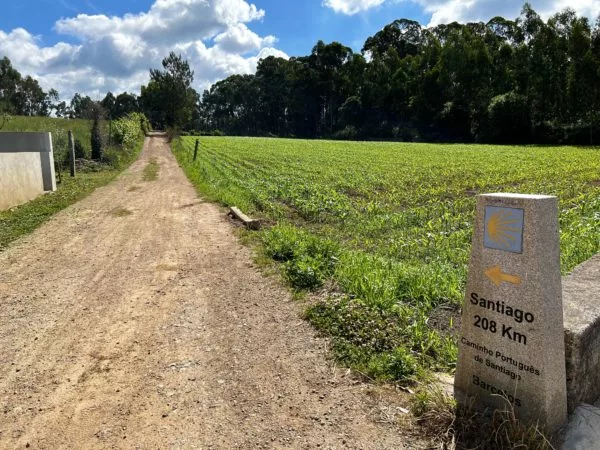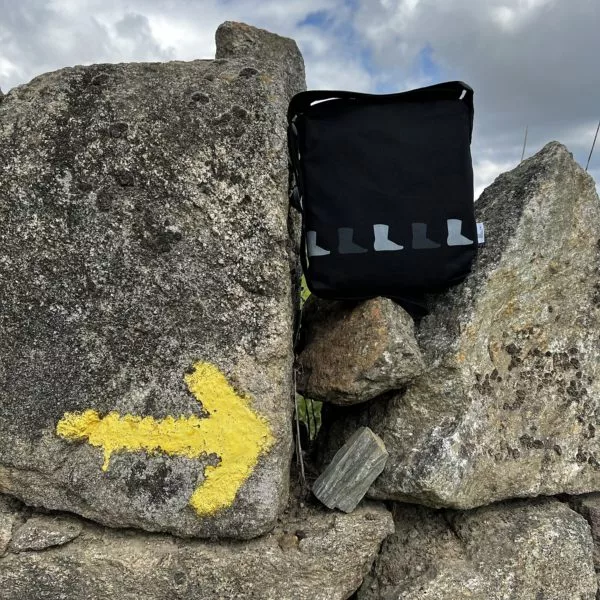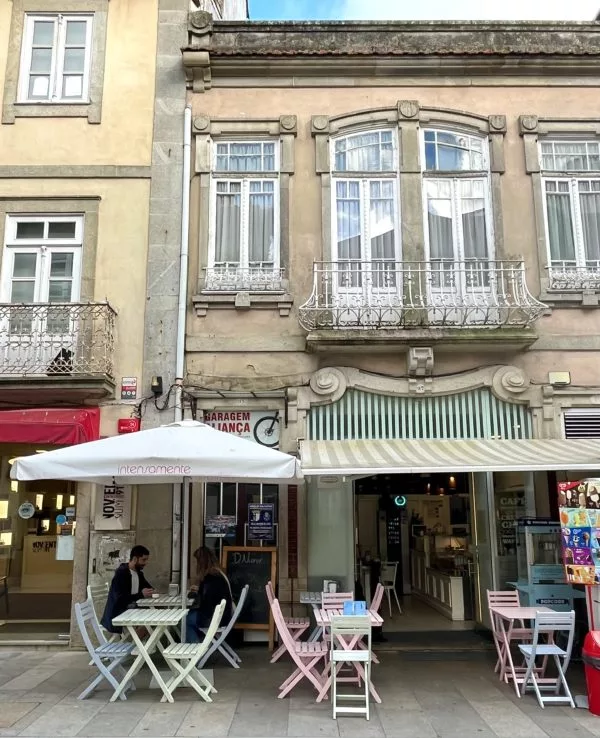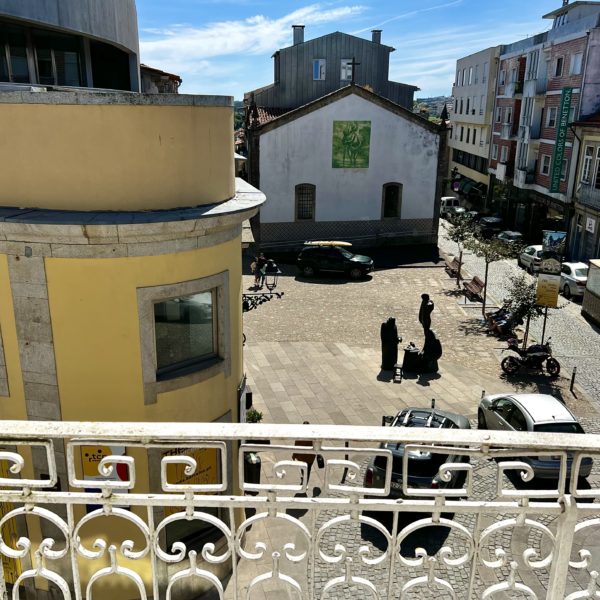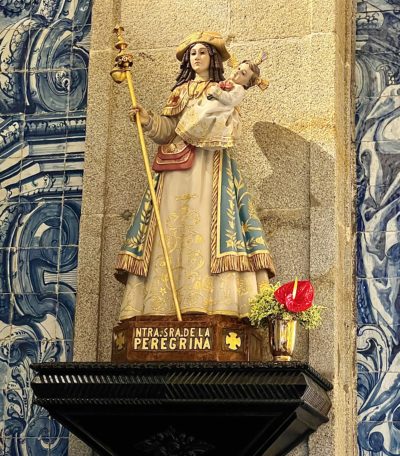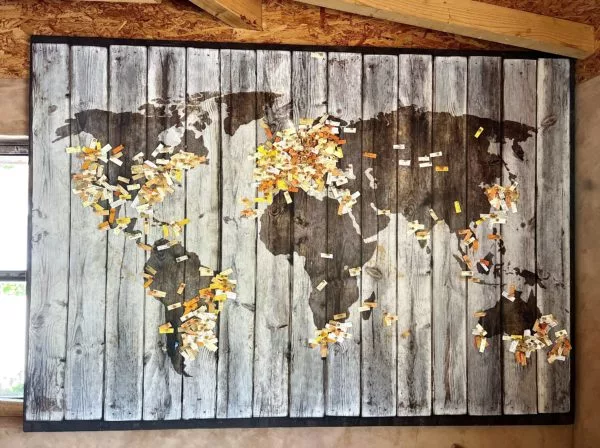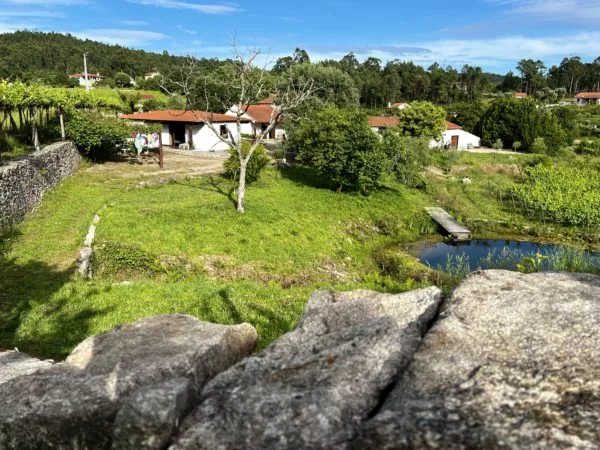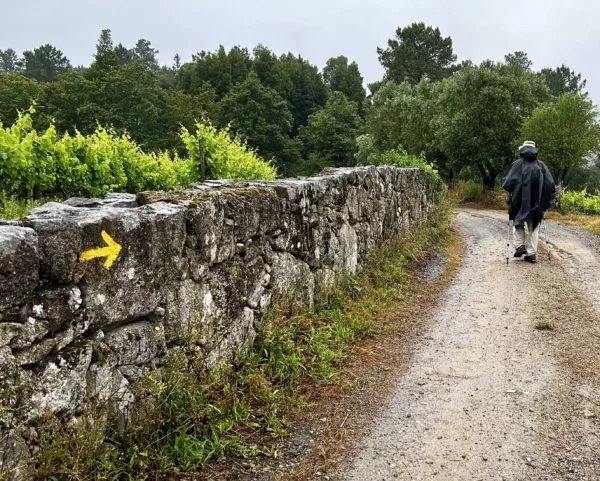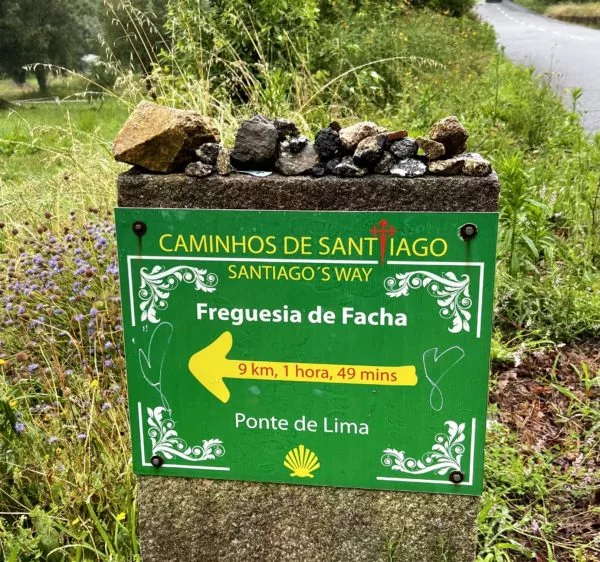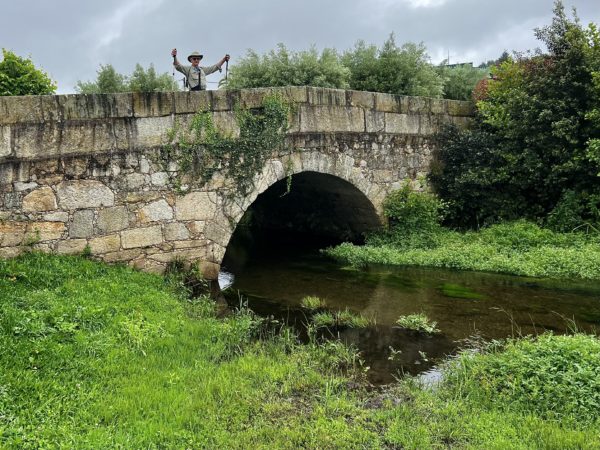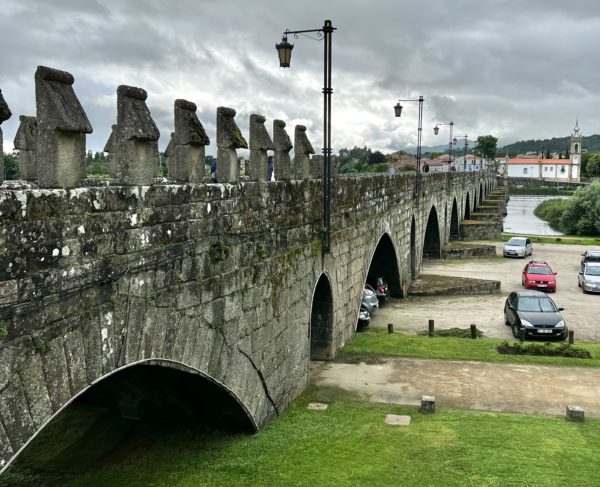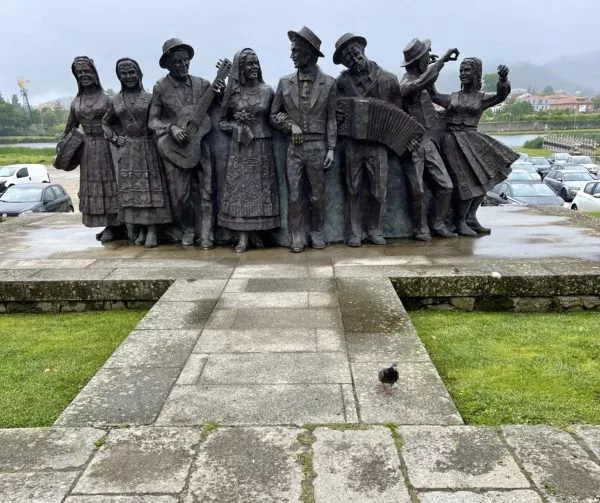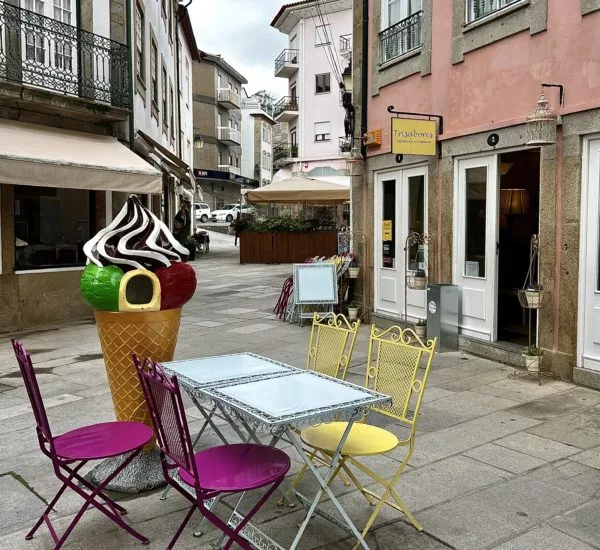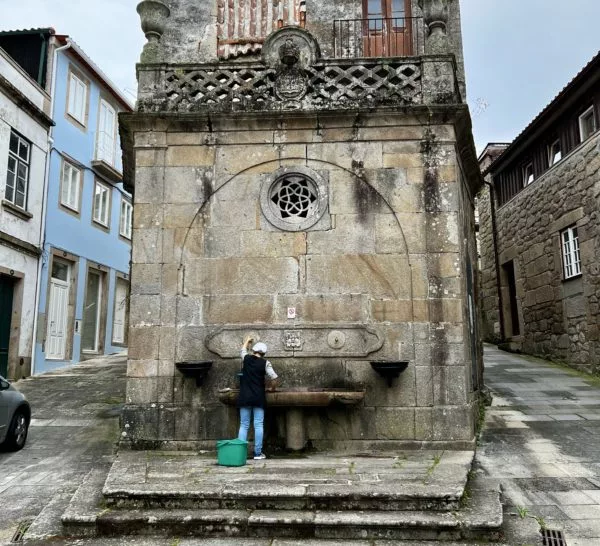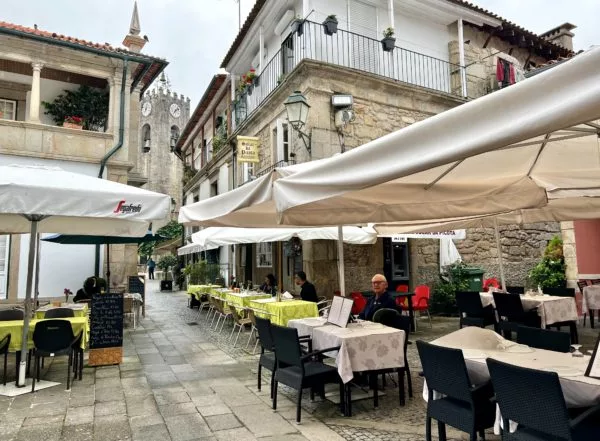
On the Central Route there were more pilgrims as expected, but there were also many people biking, especially cycling groups from Portugal. Sometimes we needed to step aside on narrower paths to let them pass by — “Bom Caminhos” were exchanged by all.
Another thing noticed on the Central Route was that many bars/cafes opened later rather than early morning. Because of this, we mostly ate breakfast at our lodging before leaving (if it was included) or bought rolls at bakeries & then found picnic spots.
Historical chapels are common along Camino Portuguese, & often their doors were open to look inside (different than in Spain where chapels & churches are usually locked). In Pereira votive candles brightened a table outside Capela da Senhora da Guia.
From Pereira it was about four miles to Barcelos. At the entrance to town stands the ruins of Castelo de Barcelos (below), where visitors can wander around the grounds for free. Built in the 15th c., the complex was damaged by Lisbon’s monumental 1755 earthquake, and then it collapsed almost 50 years later.
Today it’s an open air museum and adjacent to 14th c. Igreja Matriz de Santa Maria Maior. A block away was our lodging & the city center filled with quaint plazas, shops, and restaurants.
The 18th c. “Lavabo” (sink) found at the castle ruins
A small plaza was next to our lodging, In Barcelos Hostel & Guest House, where we stayed 2 nights — very helpful & nice accommodations!
Barcelos is associated with roosters, and images of them are found all around town, from large rooster sculptures in plazas to small ones in souvenir shops. The photo shows the typical ‘folk art’ design.
Why the rooster? It began with a legend. Briefly, as the story goes, a pilgrim who passed through Barcelos on his way to Santiago was wrongly accused of a crime and sentenced to hang. On the day of hanging, he asked to see the local judge to plead his case. The judge was at a banquet that featured a roasted rooster, and the pilgrim claimed that if he were innocent the rooster would crow at the hour of hanging.
To the judge’s surprise, the rooster did indeed crow, & the pilgrim was freed to go on his way to Santiago again. This story echos the legend of the chicken in Santo Domingo de la Calzada on Camino Frances. A rooster & hen are even kept at the church there, and when the rooster crows, it means good luck.
The Information Center in Barcelos exhibited roosters created by artists in the region. Materials used included paper mache and metal.
Located in Barcelos’ central plaza is the Baroque octagonal church Igreja do Senhor Bom Jesus da Cruz, constructed in 1704 on the grounds of an original structure from two centuries earlier. The interior artwork included a sculpture of the Virgin as a “Peregrina” wearing a cloak & hat adorned with shells, a walking stick with attached gourd, and a “pilgrim pouch”!
After spending a rest day in Barcelos, our next stop was Vitorino de Piaes. The walk there passed by more scenic landscapes and villages with cobblestoned lanes.
Cobblestones in Portugal (called calcada Portuguesa) are often found on pavement, from rural paths to urban roads. They first appeared in 1498 in Lisbon & are still maintained by skilled artisans. These limestone wonders are known to be hard on walkers’ feet, so we used extra foot pads in our shoes to cushion the walk over them.
The lodging in Vitorino, Estabulo de Valinhas, had once been a stable. The property included a ‘community building’ with a world map that held pins where guests were from — I put a pin in for San Diego.
The grounds encompassed a pond, vineyards, & olive trees.
The Green Foliage Bag checked out the old stone wall.
A communal meal outside at Estabulo de Valinhas was the highlight of our stay — walkers from France, Canada, Brazil, & Germany were seated around the table. Good food & lively conversation among the idyllic vineyard setting! The experience reminded me of the outdoor dining scene at the beginning of the film The Way.
Showers arrived during the morning’s departure from Vitorino de Piaes. Rainfall in northern Portugal & Spain can be significant, so rain gear is important to bring even in summer. Read more about gear in Camino Packing, which includes a sample packing list & ‘nitty gritty’ tips that help lighten the load.
A small shrine to St. James near Facha was among the frequent shrines seen along Camino Portuguese. They’re found in casa yards, along village streets, and on country roads. Many have decorative iron work on the front that encloses the images inside. Some include ribbons, stones, shells, and other mementos.
There were also ‘intention’ sites created by walkers from objects they left behind. One near Borgonha (below) displayed photos and notes hung on tree branches; stones with messages covered the trunk — what stories did they tell?
Dad chatted with a woman walking by her house — she wished us a “Bom Caminho”!
Markers unique to this area listed the distance & walking times to Ponte de Lima.
The Ponte da Senora das Neves in Correlha wasn’t far from Ponte de Lima, our next stop and where The Road crosses a Roman & medieval bridge.
Only 1km left to Ponte de Lima, Portugal’s oldest town
A long promenade, Avenida dos Platanos, led us to the historical center.
The bridge Ponte de Lima consists of two sections: a shorter Roman part from the 1st c. (on left side) and a longer medieval section from the 14th c. (seen in the distance) that spans the Lima River. In the foreground are a walking path and parking area.
A bronze sculpture, Allegory Feiras Nova by Salvador Vieira, represents dancers in traditional dress & was installed in 2009 along the riverfront.
Exploring side streets — lots of charm!
Part of the medieval wall
Water bottles were being filled at Fonte de Sao Joao — public fontes (fountains) such as this one are common along Camino routes and always appreciated by walkers.
For dinner we ate at a restaurant near our hotel. A shower started soon after being seated, but the large umbrella over the table provided shelter, and the sound of the raindrops added to the ambience.
Next: Labruja, Sao Bento da Porta Aberta, & Valenca, our last stay in Portugal before crossing into Spain.

